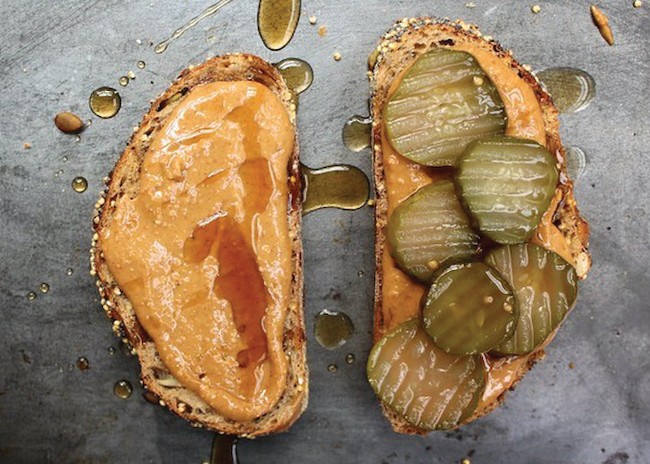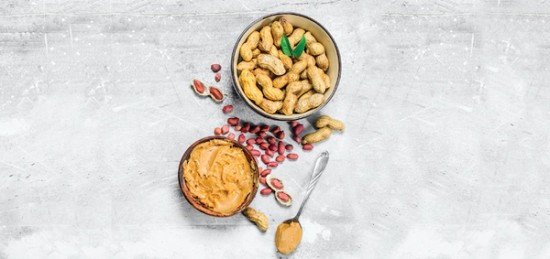By Bob Parker, NPB President & CEO

When Food Network star Ina Garten bantered on national TV with CNN’s Anderson Cooper about their rediscovered love of the PB&J last December, it was no surprise to me that the classic all-American peanut butter sandwich had risen back to the top of our collective food conscious – not only filling our bellies, but soothing our souls during trying times. And that’s what’s special about the work I do for America’s peanut farmers at the National Peanut Board (NPB).
With all the ways the pandemic has changed our shopping and eating habits, I get asked frequently how our industry has fared. At first, many are surprised to hear that peanut consumption is at an all-time high. But I think you’ll find, as they eventually do, the reasons make as much sense to your heart as they do your head.
Peanuts by the Numbers
As we have during similar times of economic uncertainty, today Americans are turning more to peanuts to meet their nutritional, financial and, yes, – even emotional needs. For our 7,000 peanut farming families, that evokes pride but also a sense of responsibility. And a commitment to live up to the trust consumers place in us.
After peanut consumption hit a low of 5.5 lbs. per capita in the United States in 1996, U.S. farmers came together to form NPB in 2000 and get to the bottom of the decline. Through the hard work of the organization and its industry partners, peanut consumption hit a record 7.6 lbs. per capita in 2020.(1) Conceivably, consumption may have gone even higher if it weren’t for limits in supply and constraints on manufacturing capacity for peanut butter. But what was the main factor behind this most recent growth?

Beginning in March of 2020, as with many foods, peanut products were wiped from retail shelves quickly and manufacturers struggled to build inventory back. Snack peanut sales were hit hard primarily from the travel halts and loss of sporting events. Candy sales also experienced an initial loss as fewer people frequented convenience stores, airport gift shops and movie theaters.

A grocery shopper expresses dismay over the empty shelves at a supermarket in March 2020. Image | Associated Press
It was clear early on in the pandemic that consumer food purchase behaviors were rapidly changing to meet our new normal. But the short-term adjustments in what and how we bought things quickly evolved into new lifestyles. More and more people bought groceries online, turned away from dining out and relied on food delivery services or prepared their meals at home. According to a recent report by the National Confectioners Association, 61% of consumers bought groceries online in 2020. Impulse buying for items like candy and snack nuts took a sharp turn downward. Parents working from home and their children attending school remotely, unimpeded by peanut restrictions, turned to the flavor, nutrition, convenience – and joy – of the peanut butter and jelly sandwich.

America’s Ultimate Comfort Food
Kathryn Hudson, recently summed it up in an article for the Toronto (Canada) Star, “All Hail the Triumphant Return of the Peanut Butter Sandwich.” She wrote that although remote schooling had brought many stresses, it has brought an unlikely joy to her family – peanut butter for lunch. Hudson called the PB&J “comfortingly delicious” and something she and her kids could enjoy between school and conference calls. Her children have experimented with different combinations of PB&Js, such as one made with an orange marmalade with bacon and balsamic vinegar. Those children may have unhappy recollections of the pandemic but will always have fond memories of the emotional bond formed with America’s ultimate comfort food.
The economic disruptions of the pandemic have placed great hardship on many U.S. families. At less than 3 cents per gram of protein, peanut butter is an incredible value when compared to meat, tuna, dairy and tree nuts.(2) Remarkable advancements by America’s peanut farmers in yield and efficiency have placed them among the low-cost producers of peanuts in the world. The price of peanut butter, when adjusted for inflation, cost the consumer 25% less in 2020(3) than it did in 1995.(2)

For the Love of Peanut Butter
As adults rediscovered their love for peanut butter during the pandemic, children learning remotely, developed an affection for it as well. Not only is it nutritious and shelf-stable, all ages love the taste, versatility and affordability. It can be made into a snack or a meal at a moment’s notice. Peanut butter provides a temporary sense of well-being and for many, brings back memories of happier times.
A recent report on consumer behavior by J.M. Smucker Company says the pandemic accelerated the growth of peanut butter by 7.1% for the 52 weeks ending November 1, 2020. Three examples of how peanut butter consumption has expanded are:
- An increase in snacking. Consumers are snacking with peanut butter and jelly more, 64% vs. 49%, in both mornings and afternoons.
- Younger generations are embracing PB&J. Millennials and Gen-Xers are turning to peanut butter and jelly for themselves and their families. More Millennials and Gen-Xers have children and worked full time in 2020, thereby are having more PB&J occasions.
- Sense of comfort. Consumers are turning to their favorite foods for more than sustenance; they offer a sense of normalcy and comfort. Consumers report a higher percentage of PB&J occasions occur when they need to unwind.

Joy the Baker’s “Dance Like Nobody is Watching” Peanut Butter and Pickle Sandwich. Image | Joy Wilson
Not surprisingly, according to Golin, chatter about peanut butter skyrocketed by 95% in 2020.(4) These conversations were driven by odd combinations or indulgent consumption moments linked to comfort or boredom, recipes, nutrition tips and affordability. There was also discussion on social media about lack of stock in stores and peanut butter being a highly requested item by food banks. NPB also saw a 55% increase in peanut butter recipe mentions on social and other media channels with 414% more mentions about its non-perishability.(4)

Launched on Jan. 24, 2020 for National Peanut Butter Day, NPB’s “Spreading Good” campaign gave the peanut emoji substance by turning all emojis used on Twitter into real peanuts for peanut butter donations to U.S. food banks. Image | NPB
Increased social media conversations about peanut butter translated to retail sales as well. According to research firm IRI, there was an 8.8% increase in peanut butter retail sales volume in 2020. Unit sales of peanut butter were up only 5.2%, as manufacturers pivoted to larger container sizes to keep pace with demand. The average retail price paid per pound was lower than the average of the previous four years.(3)

Nearly 55% of peanuts are used for peanut butter in the U.S., more than for any other category.(1) Because of taste, affordability, nutrition and shelf stability, NPB continues to see significant growth in the category, and as more peanut butter manufacturing capacity comes online and with a large 2020 crop, we expect this growth to continue.

People pick up food at the New York City mobile food pantry on the Barclays Center plaza on April 24, 2020 in Brooklyn, New York. Image | Angela Weiss | Getty
Demand for peanut butter by food banks was also unprecedented in 2020. Peanut butter manufacturers struggled to keep up with normal demand, making it difficult at times to supply food banks. Again, as manufacturing capacity ramps up in 2021 and the abundant supply finds its way, peanut butter will play a major part in reducing food insecurity.

Turning to Chocolate for Comfort
The roles of comfort and enjoyment are an important part of snacking in today’s climate. Just as we looked to peanut butter, we also turned to chocolate for comfort – and nothing makes chocolate better than peanuts. Candy Industry Magazine editor Crystal Lindell told the Los Angeles Times she always carries a Snickers bar in her purse in case of a bad day. In that same article, neuroscientist Rachel Herz said, “nature has the candy industry’s back.” Humans react to sweets, which trigger the brain to release dopamine and endorphins, providing a calming effect.

With iconic candy brands like Reese’s Peanut Butter Cups, Snickers and Peanut M&M’s, peanuts were a beneficiary of these increased sales. Per Nielsen, during the 17-week period that ended on June 27, 2020, consumers bought $3.7 billion worth of chocolate, a 6.3% increase from the comparable period last year.(5) Grocery store sales increased as movie theater, airport gift shop and convenience stores suffered. Consumers changed buying patterns, going with different pack sizes, different types and different brands as they searched depleted aisles or looked for better value.
As a result, manufacturers like Mars Wrigley adjusted production and packaging to accommodate new buying patterns by decreasing production of less popular brands and ramping up production of top-selling brands like Snickers. They also increased web inventories and produced more bagged candy to accommodate online sales.
Even though some channels have seen disruption in sales, the chocolate candy category has persevered through the pandemic and, along with it, peanuts continue to be well-positioned as a main ingredient in the top-performing candy brands.

Vendor sells peanuts outside Wrigley Field before Game Four of the 2016 World Series between the Chicago Cubs and the Cleveland Indians at Wrigley Field on October 29, 2016 in Chicago, Illinois. Image | Scott Olson | Getty
Let’s Talk Snack Peanuts
Early in the pandemic, snack peanuts were depleted from grocery shelves just as peanut butter. But consumers did not replenish snack peanuts at the same pace as peanut butter. In-shell peanuts especially lost sales when sporting events reduced or eliminated fans. Snack nuts also lost sales to impulse buyers in convenience stores.
However, 2020 was an exceptional year for snack peanuts, according to IRI retail sales data. Sales volume rose by 7.25%, leading to the highest volume year since 2016. The increase in snack peanut sales was slightly higher than the 7.2% increase for the snack nut category as a whole. Similar to peanut butter, unit sales were also down, likely an indication of fewer impulse sales of small packs of peanuts in convenience stores and airport gift shops.
For Most of Us Peanuts Represent Fond Memories in the Darkest of Times
All of this is to say that with the many trials we’ve had to endure during the pandemic, it is heartwarming to hear people share all of the ways peanut butter brings them joy and about the new generations discovering their love of peanut butter and peanuts for the first time. As an industry, we are optimistic that peanut butter, peanut candy and snack peanuts will continue to represent rare, fond memories of these darkest of times, having made lifelong emotional connections for millions of Americans. Indeed, peanuts are the ultimate American comfort food.
References
(1) NASS-USDA Stocks & Processing, Aug. 20, 2020
(2) U.S. Bureau of Labor Statistics CPI Average Price Data, U.S. city average (AP)
(3) IRI Research Firm data
(4) Golin 2020
(5) Nielsen Research June 2020
